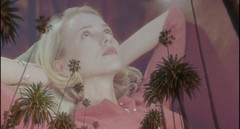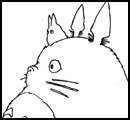It's somewhat surprising to realize that the earliest films to use CGI are some of the best. Take Spielberg's "Jurassic Park," for example. Its digital dinosaurs impressed back in 1994 and they still hold up today. The same goes for the T-1000 in 1992's "Terminator 2: Judgment Day." The aspirations for the directors were limited by the technology at the time. Early CGI was perfect for inorganic and other simple (read: hairless and clothes-less) surfaces.
In both cases, the digital effects in these two films were spared for practical effects whenever possible. The "Terminator 2" scene of the T-1000 thawing and reforming was created by tilting a flat surface covered in liquid mercury. The famous shot in "Jurassic Park" of the T-rex looking into the SUV used a giant robotic head.
Pretty much anything can be created with a computer today. But directors need to have the attitude that the sky is not the limit. George Lucas, of course, is the main culprit here. In his rush to create everything in a computer, he's lost touch with an artform that he pretty much created.
It takes some suspension of disbelief, but the original trilogy's Muppet Yoda has the weight and presence of a real creature. Any sense of artificiality can be dismissed. On the other hand, Episode II and III's digital Yoda is a soulless exercise in reaching for that real thing. It's baffling to watch digital animators waste time trying to get his ears to wiggle like a twenty-year-old puppet.
(Something effects-laden like "Sky Captain and the World of Tomorrow" or "Sin City" can be excused. The digital effects create a unique look for the film. They're not trying to be realistic.)
Peter Jackson gets it. He uses every option available for getting effects on the screen. Yes, "The Lord of the Rings" is CGI-heavy, but it's used only when absolutely necessary. Most of the establishing shots of locations are of real models. They are accentuated by CGI to fill in gaps and to connect seams.
Guillermo del Toro's style is even more pure. For all its retro innovation, "Hellboy 2" almost gets distracted by its menagerie. Better that than Lucas's digital farting space-camels.
Things bode well for del Toro's upcoming "The Hobbit."
Friday, August 29, 2008
Wednesday, August 27, 2008
The Wizard Of Gore (1970)--1/5
According to the characters in "Juno," "The Wizard of Gore" is a classic. But they live in a make-believe world where teen pregnancy is about as stressful as building a deck and people say things like "honest to blog." "The Wizard of Gore" is an endurance test. Not because of any scariness or shock value, but because it is exceptionally bad.
The title character, Montag the Magnificent, hypnotizes "volunteers" from the audience and eviscerates them onstage in various ways. On the first night, for example, a woman is sawn in half with a chainsaw in full view of the audience. The victims leave the stage and appear to be alright. Later that night, their wounds reappear and they die.
That's pretty much it.
It's mostly no surprise that a movie with this plot is not very good. However, it could have discovered it's own campy rhythm. If the actors had any training at all. If the gore was anything more than chicken livers and ketchup. If the director had altogether skipped the scene, filmed in a local restaurant, in which Saran wrap has clearly been placed on the floor so that ketchup doesn't ruin the classy 70's carpet.
There's no way that the recent Crispin Glover remake of "The Wizard of Gore" is worse than the original.

The title character, Montag the Magnificent, hypnotizes "volunteers" from the audience and eviscerates them onstage in various ways. On the first night, for example, a woman is sawn in half with a chainsaw in full view of the audience. The victims leave the stage and appear to be alright. Later that night, their wounds reappear and they die.
That's pretty much it.
It's mostly no surprise that a movie with this plot is not very good. However, it could have discovered it's own campy rhythm. If the actors had any training at all. If the gore was anything more than chicken livers and ketchup. If the director had altogether skipped the scene, filmed in a local restaurant, in which Saran wrap has clearly been placed on the floor so that ketchup doesn't ruin the classy 70's carpet.
There's no way that the recent Crispin Glover remake of "The Wizard of Gore" is worse than the original.

Monday, August 25, 2008
Who Am I This Time? (1982)--5/5
Playing like an elaboration of the powerful audition scene in "Mulholland Dr.," "Who Am I This Time" is just about perfect.
Christopher Walken is Harry, the runaway star of a small-town theatre troupe. Off-stage, he's crippled with shyness, unable even to make eye contact. Onstage, he's, well, an actor of Christopher Walken's caliber. His lead performances bring the audience to tears and cause the young ladies in town to swoon.
New in town, Susan Sarandon is cast as Blanche opposite Walken's virtuosic Stanley in "A Streetcar Named Desire." She instanly falls for Walken, without knowing his true nature.
The scenes in the town are intentionally broad. The film takes place in a Gilmore Girls-esque universe where the townspeople are all on a first-name basis with each other. The effect of this is that the artificial scenes onstage are more real than the external scenes. The acting is so good in the play that it instantly becomes its own story. By the end of the sixty-minute story, Sarandon has managed to invert reality for Walken. If he can't communicate except when he's acting, why not pretend he's always acting?
Christopher Walken is Harry, the runaway star of a small-town theatre troupe. Off-stage, he's crippled with shyness, unable even to make eye contact. Onstage, he's, well, an actor of Christopher Walken's caliber. His lead performances bring the audience to tears and cause the young ladies in town to swoon.
New in town, Susan Sarandon is cast as Blanche opposite Walken's virtuosic Stanley in "A Streetcar Named Desire." She instanly falls for Walken, without knowing his true nature.
The scenes in the town are intentionally broad. The film takes place in a Gilmore Girls-esque universe where the townspeople are all on a first-name basis with each other. The effect of this is that the artificial scenes onstage are more real than the external scenes. The acting is so good in the play that it instantly becomes its own story. By the end of the sixty-minute story, Sarandon has managed to invert reality for Walken. If he can't communicate except when he's acting, why not pretend he's always acting?
Wednesday, August 20, 2008
Star Wars: The Clone Wars (2008)--3/5
"The Clone Wars" is a beneficiary of the rapidly eroding expectations engendered by the "Star Wars" prequels. Unsurprisingly, it's a better film than all of those prequels. The complete digital conversion finally gives life to characters previously played by real actors. Well, some life. The character animation on display is barely better than the fourteen-year-old "ReBoot" and the director has said he was inspired by "Thunderbirds." Still, better than Hayden Christensen.
The animation of everything else--those (relatively) easy-to-render ships, droids, and flat surfaces--is excellent, indistinguishable from the animation in the live-action chapters. ("Live-action" is an anachronistic term here. The prequels are mirror-image "Roger Rabbit" films, with human characters interacting with swaths of animation.)
Scenes of characters standing around and talking are kept to a minimum. As a result, the pace of "The Clone Wars" rarely flags. It consists of mostly of action scenes. This is probably the best thing about the film. Although it's more space junk, at least it's not more incredibly boring space junk.
The whole movie has a trivial sheen to it. Since it takes place between Episodes II and III, we already know the outcome of the battles. Newly introduced characters are little-better than redshirts on "Star Trek." At least, they will be once the New Show! Coming Soon! starts its run on Cartoon Network.
The animation of everything else--those (relatively) easy-to-render ships, droids, and flat surfaces--is excellent, indistinguishable from the animation in the live-action chapters. ("Live-action" is an anachronistic term here. The prequels are mirror-image "Roger Rabbit" films, with human characters interacting with swaths of animation.)
Scenes of characters standing around and talking are kept to a minimum. As a result, the pace of "The Clone Wars" rarely flags. It consists of mostly of action scenes. This is probably the best thing about the film. Although it's more space junk, at least it's not more incredibly boring space junk.
The whole movie has a trivial sheen to it. Since it takes place between Episodes II and III, we already know the outcome of the battles. Newly introduced characters are little-better than redshirts on "Star Trek." At least, they will be once the New Show! Coming Soon! starts its run on Cartoon Network.
Tuesday, August 19, 2008
List--Movies in Which the First Shots are the Best Shots in the Whole Movie
1. Touch of Evil--An impressively long take that shows a time bomb being placed in the trunk of a car, follows the main characters down a street as the car weaves among a crowd, and ends with the bomb exploding off-screen.
2. The Man Who Wasn't There--A static black-and-white shot of a barber's pole. The spiral creates an optical illusion of an endless pole. The rest of the film isn't so hot, so this bravura shot outclasses anything that follows.
3. A Clockwork Orange--The shot opens on a close-up of Malcolm McDowell. The camera slowly zooms out to show the *futuristic* Korova Milk Bar. An electronic version of Purcell's "Music for the Funeral of Queen Mary" plays.
2. The Man Who Wasn't There--A static black-and-white shot of a barber's pole. The spiral creates an optical illusion of an endless pole. The rest of the film isn't so hot, so this bravura shot outclasses anything that follows.
3. A Clockwork Orange--The shot opens on a close-up of Malcolm McDowell. The camera slowly zooms out to show the *futuristic* Korova Milk Bar. An electronic version of Purcell's "Music for the Funeral of Queen Mary" plays.
Movie Complaint
It seems like every time a plan for a first date is made in a movie, the characters should have no idea what's going to happen. Sample dialogue:
Character #1: Hey, I was wondering if you, umm, would want to go out sometime?
Character #2: Alright, how's Friday.
Character #2 drives off
Character #1 (thinking): Wait! What time? Who's picking up whom? Where are we going? What's your number, so we can make more specific plans? What's your name?
Character #1: Hey, I was wondering if you, umm, would want to go out sometime?
Character #2: Alright, how's Friday.
Character #2 drives off
Character #1 (thinking): Wait! What time? Who's picking up whom? Where are we going? What's your number, so we can make more specific plans? What's your name?
Subscribe to:
Comments (Atom)

